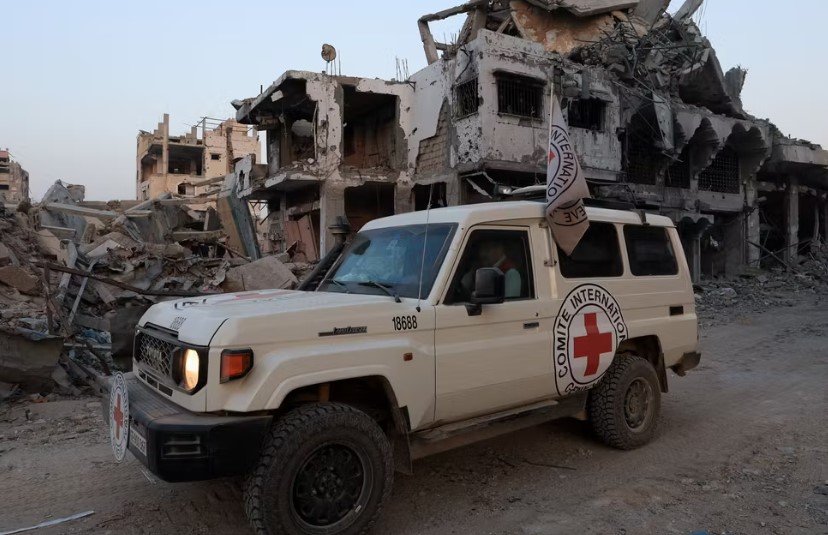Israel received the remains of a hostage from Gaza on November 7, 2025, handed over by the Red Cross as part of a US-brokered ceasefire. This marks another step in the ongoing process to return bodies held since the 2023 conflict, with Palestinian groups like Hamas turning over the remains amid a fragile truce that began in October.
Background of the Hostage Crisis
The hostage situation stems from the October 7, 2023, attack by Hamas on Israel, which led to the capture of over 250 people and sparked a major war in Gaza. Many hostages died during the fighting, and their remains became a key issue in peace talks.
Efforts to recover them gained momentum with the ceasefire deal last month. Under this agreement, Hamas pledged to release living hostages first and then return the bodies of those who had died.
The process has been slow, with accusations from both sides about delays. Israel claims Hamas is holding back to gain leverage, while Palestinian officials say rubble from airstrikes makes recovery hard.

Recent handovers show progress, but families of the missing continue to push for faster action.
Details of the Latest Handover
On November 7, the Red Cross facilitated the transfer of one hostage’s remains from Khan Yunis in southern Gaza. The Israeli military confirmed the coffin crossed into Israel and went to a forensic center in Tel Aviv for identification.
This follows similar transfers earlier in the week. For instance, on November 5, another set of remains was handed over, and on November 4, the body of a dual US-Israeli citizen was returned.
Hamas’s armed wing stated they found the body in Khan Yunis and passed it to the Red Cross. The handover fits the ceasefire terms, which require returning all deceased hostages.
So far, 22 out of 28 promised bodies have been returned, including those of Israelis, a Thai worker, a Nepali, and a Tanzanian student.
The remaining six include four Israelis, one Thai, and a soldier killed in 2014.
Key Terms of the US-Brokered Ceasefire
The ceasefire, brokered by the United States, took effect in October 2025 after months of intense fighting that killed tens of thousands. It aimed to end the violence and address humanitarian needs in Gaza.
Under the deal, Hamas released 20 living hostages in exchange for hundreds of Palestinian prisoners. The agreement also covers the return of deceased hostages’ remains.
Other provisions include aid deliveries to Gaza and limits on military actions. Both sides have mostly stuck to the truce, though tensions remain high.
Here are some core elements of the ceasefire:
- Release of living hostages first, followed by remains.
- Prisoner swaps at a ratio favoring Palestinians.
- International oversight by groups like the Red Cross.
- Temporary halts to fighting to allow safe transfers.
Experts say the deal’s success depends on trust, which has been shaky due to past violations.
Impact on Families and Communities
The return of remains brings closure to some families but highlights the pain of those still waiting. Funerals have drawn large crowds, with mourners honoring the deceased as symbols of the conflict’s toll.
In Israel, public pressure on leaders to secure all hostages has grown. Support groups offer counseling, and communities hold vigils to remember the victims.
On the Palestinian side, the war has devastated Gaza, with over 40,000 reported deaths and widespread destruction. The ceasefire has allowed some rebuilding, but aid groups warn of ongoing crises like food shortages.
This handover also affects international relations. The US has pushed for full compliance, warning that failure could end the truce.
Challenges in Recovering Remaining Hostages
Recovering the last bodies faces hurdles. Much of Gaza lies in ruins, burying remains under debris from bombings.
Hamas says searches are ongoing but complicated by safety risks. Israel accuses the group of using the bodies as bargaining chips.
To track progress, here is a timeline of recent handovers:
| Date | Hostage Details | Handover Location |
|---|---|---|
| November 2, 2025 | Three deceased hostages | Southern Gaza |
| November 4, 2025 | Dual US-Israeli citizen Itay Chen | Central Gaza |
| November 5, 2025 | One unidentified hostage | Gaza Strip |
| November 7, 2025 | One from Khan Yunis | Southern Gaza |
This table shows a pattern of steady, if slow, returns since the ceasefire started.
Ongoing talks aim to speed up the process, with mediators like the UN involved.
What Happens Next in the Ceasefire
Looking ahead, the focus is on the final six remains. Negotiators hope to complete returns by year’s end, but setbacks could arise from renewed clashes.
The US is seeking UN support for a Gaza security force to maintain peace. This could stabilize the region and prevent future hostage crises.
Analysts predict that full compliance might lead to broader peace talks, addressing issues like Gaza’s reconstruction and border security.
For now, the truce holds, offering a rare break in a long conflict.
Share your thoughts on this development in the comments below, and pass this article along to others interested in Middle East updates. Your input helps keep the conversation going.
